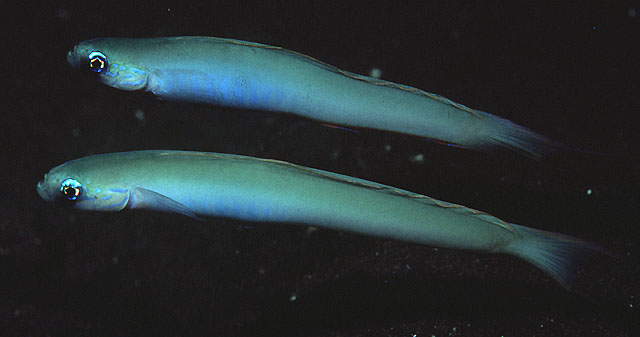| Microdesmidae (Wormfishes), subfamily: Ptereleotrinae |
| 12 cm SL (male/unsexed) |
|
reef-associated; marine; depth range 6 - 50 m |
| Indo-Pacific: Seychelles and Chagos Islands to the western Pacific. |
|
Dorsal spines (total): 7-7; Dorsal soft rays (total): 35-39; Anal spines: 1-1; Anal soft rays: 33-37; Vertebrae: 26-26. Pale blue to yellowish; upper abdomen with a broad area of deeper blue; a bar, broad and blackish extending ventrally from eye onto chin; iris yellow, upper and lower edges broadly deep blue; postorbital head with irregular, iridescent markings. A single, continuous dorsal fin with spinous part lower than soft portion. Chin with fleshy protuberance narrowing to a thin low, median fold. Scales very small, fully embedded and well separated. Named as such in reference to its continuous dorsal fin. |
| Lives in reef habitats from shallow coastal slopes to outer reef lagoons and slopes below drop-offs to 50 meters, among rubble (Ref. 48637). Occurs in pairs and its burrow may be in coral rock or sand. Monogamous (Ref. 52884). Feeds on zooplanktons (Ref. 89972). They tend to form large, though diffuse, colonies; may be due to a propensity to aggregate or may be a result of the ecological requirements for the species (for which type of substratum, current pattern, and water depth among the most important) which restrict the areas of settlement of the postlarvae. |
|
Least Concern (LC); Date assessed: 12 March 2015 Ref. (130435)
|
| harmless |
|
Source and more info: www.fishbase.org. For personal, classroom, and other internal use only. Not for publication.

